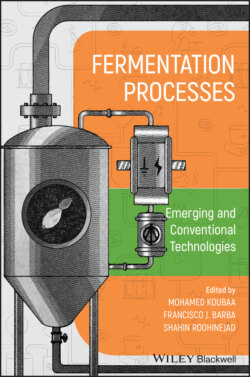Читать книгу Fermentation Processes: Emerging and Conventional Technologies - Группа авторов - Страница 19
1.2.2.1 Glycolysis Pathway
ОглавлениеIn the glycolytic pathway, occurring in all tissues, glucose is oxidized to provide energy (i.e. ATP) and intermediates for other cellular metabolic pathways. Glycolysis is at the hub of carbohydrate metabolism where glucose is converted to pyruvate following a series of 10 enzymatic reactions (Figure 1.2). This metabolic pathway is known as aerobic glycolysis, as the reoxidation of the NADH formed during the oxidation of glyceraldehyde 3‐phosphate requires O2. Aerobic glycolysis sets the stage for the oxidative decarboxylation of pyruvate to acetyl coenzyme A (acetyl‐CoA), a major fuel of the tricarboxylic acid cycle (Ferrier 2017).
During glycolysis, two ATP molecules are initially consumed to phosphorylate glucose, which thus receives an essential energy supply to continue the catabolic pathway. Subsequently, two molecules of NAD+ oxidize phosphorylated sugar and are reduced to NADH + H+. During these reactions, which will lead to the synthesis of two molecules of pyruvic acid from a glucose molecule, a part of the energy released allows the direct synthesis of four molecules of ATP. Considering that two molecules of ATP are consumed and four are produced, glycolysis presents a net balance of two molecules of ATP for each molecule of oxidized glucose.
Figure 1.2 Glycolysis and citric acid cycle pathways.
